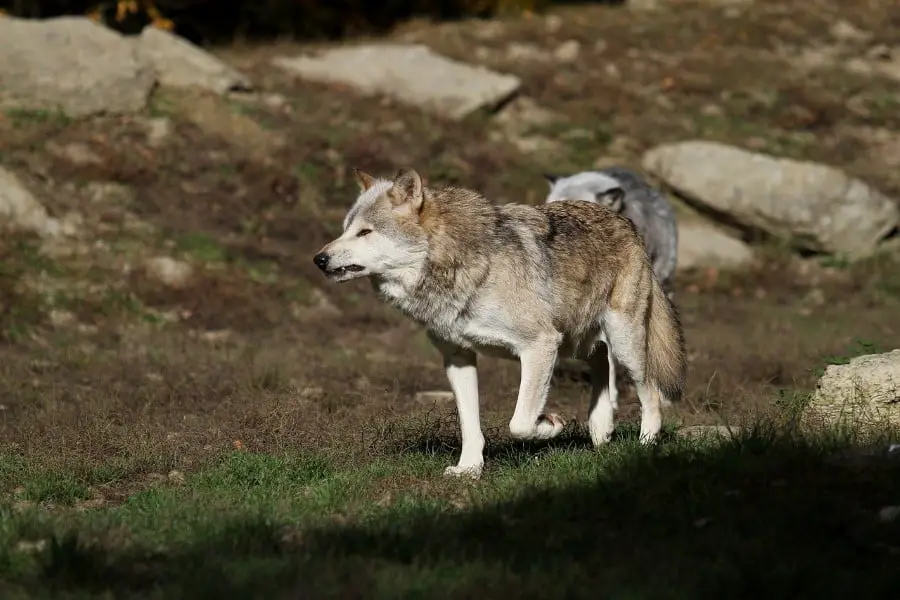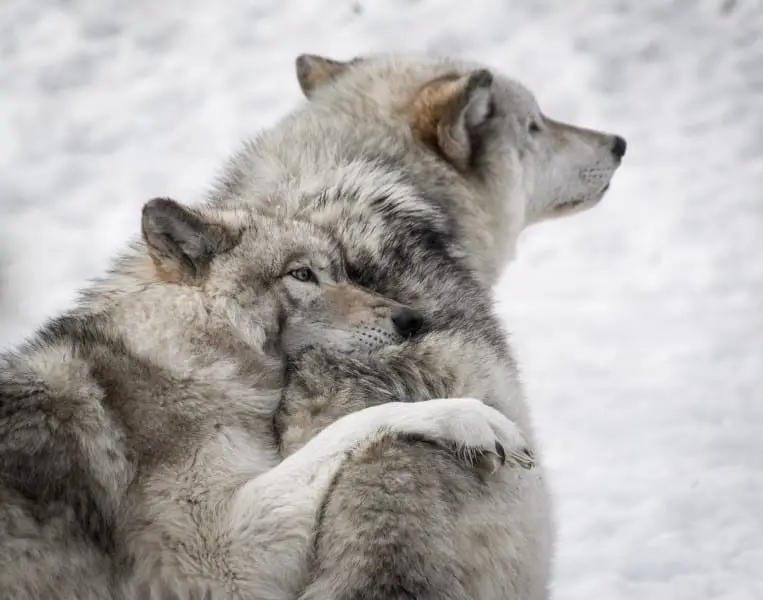Wolves are those interesting wild animals that many will always love to learn more about – usually at a distance though!
Belonging to the wild dog family, wolves do maintain a distance from humans and are considered a rather ominous creature. Because they’re almost always out of human sight, it’s always been a curiosity to know where and how they live.
While many types of wolves are different from one another, this article will discuss timber wolves and where they live. But first, let’s give you the quick answer to start you off…
Where do Timberwolves live? Timberwolves live away from human settlements and are very versatile when choosing their habitats. So they live in taigas, tundra’s, forests, and grasslands, mountains brushlands, prairies, and deserts. Timberwolves live in packs with set territories, sharing a strong social bond within the pack.
A timber wolf or timberwolf is a common name for several subspecies of grey wolf Canis lupus – of which there are 38 subspecies, some of which have become extinct. Of these 38 there are also eastern timber wolves, which are also called eastern wolves, or Algonquin wolves, or even deer wolves
Geographic dispersion
Looking back in history, timberwolves were renowned as one of the species that had the widest geographic range. However, with the human settlements expanding into the timberwolf’s domain, timberwolves no longer exist in many parts of the world, especially in their former lands.
But today, these wild creatures still live and thrive in isolated sections of Canada, Alaska, Asia and parts of Europe.
In the United States alone, timberwolves live in only a handful of states such as Alaska Michigan, Montana, and Wisconsin.
While these tend to be some common areas where timberwolves are known to live, when looking into the geographic dispersion of this animal it extends to the Northern part of Africa, Greenland, China, Germany, Romania, Armenia, France, and northern Spain.
It’s also important to mention, that the more that lands are cleared to build homes near the forest, it has meant that timberwolves come closer to living near to human settlements, although they are animals that prefer living away from human sight.

Local habitats
There’s no specific place where exactly timberwolves live. This is mainly because they’re very adaptable creatures when it comes to choosing their habitats.
However, any place they choose to live mainly takes into consideration human establishments. So, in terms of environments, timberwolves often live in the following habitats:-
- Taigas
- Tundra’s
- Forests
- Grasslands
- Mountains
- Brushlands
- Prairies
- Deserts
Given the terrain and climate of such areas, timberwolves are generally able to maintain their distance from humans – and habitats that humans rarely explore are perfect places.
Humans, on the other hand, largely consider timberwolves as a dangerous predator. Fair to say that timberwolves – and wolves in general, are wild animals and obviously, humans prefer avoiding their habitats.
Unfortunately, humans clearing forests and establishing their settlements have narrowed the distance timberwolves prefer in choosing their habitats.
Where does the eastern timber wolf live?
The eastern timber wolf is native to the northeastern side of the Great Lakes region in America. So they’re mainly found living in and around Ontario’s Algonquin Provincial Park.
They’re also seen venturing out into Quebec in Canada, Minnesota, and Manitoba. The eastern timber wolves prefer living in the coniferous and mixed forests in the north and when it comes to the south, they prefer the deciduous and mixed forests environment.
However, we should also mention that the eastern timber wolf population is steadily in decline in the south, mainly from around southern Ontario.
The reason for such disappearance tends to be due to the excessive forest clearance and farmland developments. This has now accounted for less than 500 eastern wolves living in the wild within those regions.
Apart from this, hybridization is also seen as a reason for the continuous reduction of the eastern timber wolf population. So, for now, the highest densities of eastern timber wolf is thought to be in the Algonquin Provincial Park.
Do timberwolves live alone or in groups?
When asking the question of where do timberwolves live, it makes sense to include who they live with in terms of if they are pack animals or not.
Wolves, in general, live, hunt and travel in packs. A pack usually doesn’t consist of many members, grey wolves usually have between 6 and 8 in a pack, but timberwolves have been known to live in packs of two up to dozens of members.
A “pack” in the wolf world means a family with an adult breeding pair. So a timber wolf pack will have the alpha male and the alpha female and their offspring of different ages. The ability of timber wolves to live with great social bonds is what makes living in packs possible.
Living in packs is much more interesting among timberwolves. When living in packs there is a dominant hierarchy that everybody in the pack is bound to follow.
This hierarchy helps to maintain the order in which they can live with harmony. The alpha male and the alpha female (the breeding pair) are on the top of the hierarchy and the offspring are the subordinates.
This breeding pair continually assert themselves over their subordinates. The breeding pair also guides the subordinates on how they should live and what activities they should carry out.
Apart from this, when living as a pack the males and females of the pack have different duties and chores.
The females are directed for care and defending the pups. Whereas the males are responsible for foraging for food and guiding through travels and related activities.
When hunting both the genders are usually very active in attacking and killing prey, but when it comes to summer Timberwolves generally hunt alone, rather than in packs.
When living in packs, timber wolves are very organized and structured through great harmony.
The harmony and bond of individual packs can be so strong that one pack of timber wolf will not hesitate in attacking and killing another pack of timber wolves.

Timberwolves live in territories
Each timber wolf pack has a territory. The territory can extend from 30 to 1,200 square miles (80 t0 3000 square km).
The territory is usually on the larger size depending on the abundance of prey. These territories are usually vigorously defended against their own kind of neighboring packs.
Intruders from neighboring packs of timber wolves are killed, whereas in some situations they are potentially accepted. They mark their territories to let their neighboring packs understand the boundaries through urine and feces and sometimes through howling.
Why Timberwolves are called “Timberwolves” and not just gray wolves
We touched on this earlier, but to get further into this, it should be noted that there are only two species of wolves that exist in the world the: gray wolf and the red wolf. We are discussing subspecies here, so the timber wolf is considered a subspecies of the gray wolf.
Even the Indian wolf, Himalayan wolf, and the Mexican wolf are also considered a subspecies of the gray wolf.
When closely observed, timber wolves are slightly smaller, less stocky and have a lighter build than gray wolves. Apart from this, timberwolves share most of the gray-wolf related physical characteristics, which makes it difficult to differentiate between a gray and a timber wolf.
Learning resources
We’ve found the ideal resources to continue your learning at home and at school on amazon. Help support our efforts for wildlife causes and keep this site working for nature. Amazon also donates to Wild-life related charities!
Want to learn more about Wolves in general? Indulge your passion for wolves and get educated further with these fascinating books…
Wolves: Behavior, Ecology, and Conservation
Video resources
Final thoughts
Wolves have always fascinated us, and, although we may not all want to come face to face with a wolf pack, we all still love the idea of wolves, perhaps because they’re closely related to dogs, or maybe it’s the mysterious nature of them.
We hope this has been useful in understanding more about where timberwolves live.
This content has been checked and verified by a qualified veterinary practitioner. The article has been reviewed by our editorial board and has been approved for publication in accordance with our editorial policy.
